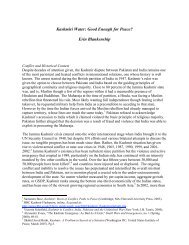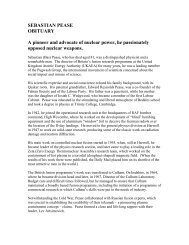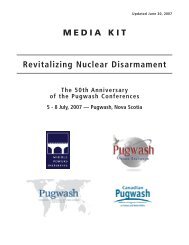Eliminating Stockpiles of Highly Enriched Uranium - Pugwash ...
Eliminating Stockpiles of Highly Enriched Uranium - Pugwash ...
Eliminating Stockpiles of Highly Enriched Uranium - Pugwash ...
You also want an ePaper? Increase the reach of your titles
YUMPU automatically turns print PDFs into web optimized ePapers that Google loves.
emain the choice for the vast majority <strong>of</strong> terrorists, some high-pr<strong>of</strong>iled terrorist<br />
groups have actively been seeking nuclear material and nuclear explosive<br />
capabilities. 13<br />
The threats associated with unirradiated HEU – including nuclear terrorism – thus<br />
call for elimination <strong>of</strong> as much HEU as possible, as soon as possible.<br />
Acquiring fissile material for a nuclear explosive device is by far the hardest part for<br />
potential nuclear terrorists, yet it is also the easiest step to check. 14 Reducing the<br />
threats from HEU is pretty straightforward, from a technological point <strong>of</strong> view. As<br />
opposed to plutonium disposal, the elimination <strong>of</strong> HEU is achieved by simply<br />
blending it down, that is mixing it with natural or depleted uranium to low enriched<br />
uranium (LEU).<br />
LEU cannot be used to manufacture nuclear explosive devices. This LEU<br />
would have to be (re)enriched, which is a difficult process beyond the capabilities <strong>of</strong><br />
sub-national terrorist groups and most states. For example, Saddam Hussein’s Iraq<br />
failed in its attempts, even after investing significant resources in this clandestine<br />
enrichment effort.<br />
Production <strong>of</strong> crude nuclear explosive devices with HEU<br />
It is considerably simpler to make a bomb using highly enriched uranium than to<br />
make one using plutonium, even though the critical mass is larger for HEU than for<br />
plutonium. 15 HEU allows for the use <strong>of</strong> the so-called “gun-type” nuclear weapon<br />
configuration, a reliable and fairly robust design that could be designed and built in a<br />
fairly crude manner. 16 A piece <strong>of</strong> HEU, preferably in metallic form, is propelled<br />
(using conventional high explosives or some other means) into another piece <strong>of</strong> HEU,<br />
creating a super-critical mass and thus a chain reaction. This simple design was first<br />
used in the weapon dropped on Hiroshima in 1945. The device was never tested<br />
before being used.<br />
The South-African nuclear weapon programme demonstrated the convenience<br />
<strong>of</strong> manufacturing HEU explosive devices based on the gun-type configuration. South<br />
Africa indigenously produced nuclear devices based on the simple uranium gun-type<br />
weapon principle in spite <strong>of</strong> an international embargo. Relying solely on its own<br />
domestic resources, the apartheid regime produced six nuclear weapons. The weapons<br />
were later dismantled.<br />
In contrast, any nuclear explosive device based on plutonium requires the use<br />
<strong>of</strong> an implosion configuration, where the fissile material is swiftly and simultaneously<br />
compressed into a super-critical mass. Construction <strong>of</strong> such implosion devices is<br />
13 Morten Bremer Mærli, “Nuclear Terrorism: Threats, Challenges and Responses”,<br />
Atlanterhavskomiteen, Security Policy Library, No. 8,<br />
http://www.atlanterhavskomiteen.no/publikasjoner/sp/2002/8.htm , September 2002.<br />
14 Former Senator Sam Nunn, quoted in Bunn, Matthew, Anthony Wier, and John P. Holdren.<br />
Controlling Nuclear Warheads and Materials: A Report Card and Action Plan. Washington, D.C.:<br />
Nuclear Threat Initiative and the Project on Managing the Atom, Harvard University, March 2003.<br />
http://www.nti.org/e_research/cnwm/overview/cnwm_home.asp<br />
15 David Bodansky, Nuclear Energy: Principles, Practices and Prospects Woodbury, New York, 1996.<br />
16 A. Narath, "The Technical Opportunities for a Sub-national Group to Acquire Nuclear Weapons", in:<br />
Proceedings <strong>of</strong> the XIV Amaldi Conference on Problems <strong>of</strong> Global Security; Atti dei Convegni Lincei<br />
190, Roma, Accademia Nazionale dei Lincei, 2003, p.19-32.<br />
14







